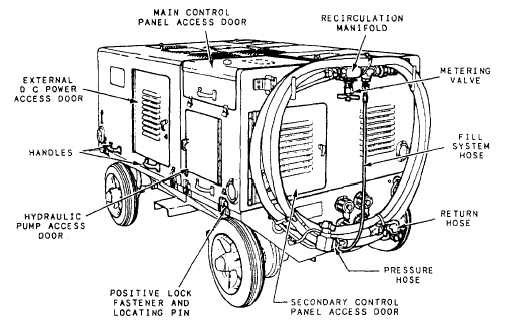aircraft hydraulic systems with fluid obtained directly
from the 10-gallon container. It can be operated by
one person, and it is used in those applications where
the fluid capacity of the H-250-1 servicing unit
(1 gallon) or HSU-1 servicing unit (3 gallons) is
inadequate.
The hand pump is used to deliver
3-micron (absolute) filtered fluid.
The main frame assembly of the fluid service cart
consists of a two-wheel dolly having a tubular handle
extending outward so you can hand push (or pull) the
cart. The frame contains an inner bridle, which, with
the cart in its upright position, may be positioned
around and secured to a 10-gallon fluid drum without
lifting the drum. Once it is installed in the bridle, you
can move the drum using the dolly, or tilt it back
90 degrees from vertical to the operating position.
Hydraulic fluid is removed through a swivel
fitting installed in a 2-inch hole. The swivel fitting is
connected by a flexible hose to a single-action pump
that has a displacement of 2 fluid ounces per stroke at
0 to 250 psi. A replaceable 3-micron (absolute)
disposable filter installed at the pump assembly base
removes particulate contamination from the fluid
being delivered to the suction side of the pump. A
check valve in the filter assembly prevents operation
without an installed filter element.
Filtered fluid from the hand pump is routed to an
air trap assembly, which contains a special chamber
that removes any free air present in the fluid. The air
trap assembly contains a manual bleed valve for
venting collected air and a 0- to 300-psi pressure
gauge for monitoring output pressure. Fluid is
delivered to the system or component being serviced
by a 15-foot service hose. A 3-micron, in-line filter
assembly is located near the discharge end of the
service hose to ensure against system contamination.
PORTABLE HYDRAULIC TEST STANDS
Several different models of portable hydraulic
test stands are currently used in the fleet. The primary
function of these stands is to provide external ground
power to aircraft hydraulic systems. The stands vary
as to fluid-flow capabilities, source of prime power,
and manufacturer. A complete description of specific
operating instructions for portable hydraulic test
stands is not contained in this section. However,
some of the common test stands are discussed, so you
will have some knowledge of portable hydraulic test
stands.
NOTE: The AHT-64 test stand is being
replaced by the A/M27T-5 test stand;
therefore, it is not covered in this chapter.
A/M27T-3 Portable Hydraulic Power Unit
The A/M27T-3 power unit is designed to be
directly connected into the aircraft hydraulic system,
Figure 4-11 .—A/M27T-5 portable hydraulic power supply, rear and right-hand side view.
4-26

